|
|
|
Sort Order |
|
|
|
Items / Page
|
|
|
|
|
|
|
| Srl | Item |
| 1 |
ID:
160611
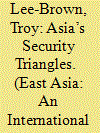

|
|
|
|
|
| Summary/Abstract |
Since the early years of the twenty-first century, a number of key regional governments have consciously chosen to alter the way they talk about the region, and have now largely shifted from using the ‘Asia-Pacific’ to the ‘Indo-Pacific’ construct. But after three decades of utilising the ‘Asia-Pacific’ concept, why has this been the case and how might this shift in geographical conceptualisation alter the strategic framework of the region? This paper argues that the ‘Indo-Pacific’ is a regional reconceptualisation utilised by Japan, Australia, India and the USA to address deficiencies in Asia’s maritime security and institutional architecture, which are being simultaneously influenced by a more assertive Chinese posture and waning U.S. influence. Additionally, the Indo-Pacific concept has developed in tandem with a transformation in the regional security architecture. The utilisation of maritime minilateralism between Japan, India, Australia and the USA supplements Asia’s bilateral American alliances, with an array of trilateral security dialogues or ‘security triangles’. The Asia-Pacific to Indo-Pacific shift is really an instance of an emerging minilateral security regionalism, rather than the predominant forms of bilateral and multilateral security and economic regionalism that have dominated Asia in recent decades.
|
|
|
|
|
|
|
|
|
|
|
|
|
|
|
|
| 2 |
ID:
080909


|
|
|
|
|
| Publication |
2008.
|
| Summary/Abstract |
Neorealists argue that Japan's response to the rise of China has been to draw closer to the United States in order to balance Chinese power. In practice, the Koizumi and Abe administrations differed in their responses to the growth of Chinese power in East Asia. While Prime Minister Koizumi sought to consolidate the US-Japan alliance, Prime Minister Abe adopted a dual-track approach, combining enhanced bilateralism with enhanced regionalism. Although buttressing the US-Japan alliance, this strategy aimed to balance China by building a containment coalition with other Asia-Pacific states. Japan's signing of a security declaration with Australia in March 2007 was an important element of Abe's strategy, and marked a subtle shift in Japanese security policy from exclusive bilateralism to modest minilateralism. Although congruent with US strategic interests, this move supported Prime Minister Abe's ambition to exercise more autonomous influence over the regional security order
|
|
|
|
|
|
|
|
|
|
|
|
|
|
|
|
| 3 |
ID:
172305
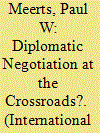

|
|
|
|
|
| Summary/Abstract |
While interstate negotiation is becoming more important than ever in guiding the course of world affairs, it is in danger of being weakened as a consequence of the erosion of multilateral diplomacy. Multilateral organizations and cooperation between states has opened new pathways for negotiation, stabilized the world, and served to equalize power distribution. Growing multilateralism has protected negotiation processes and offered smaller powers more of a say in world affairs. However, with the current trend for powerful countries to undermine multilateral negotiation processes in favor of bilateral and minilateral power-based negotiations, global political gaps are widening. This will undermine small countries and middle powers that want to use diplomatic negotiation as their main tool to influence others. The consequence could be a process of diplomatic negotiation used by hegemonic powers to further their interests to the detriment of the less powerful.
|
|
|
|
|
|
|
|
|
|
|
|
|
|
|
|
| 4 |
ID:
190896


|
|
|
|
|
| Summary/Abstract |
The Middle East and South Asia can be defined as interlinked political spaces that experience deepening interactions of their energetic and ambitious regional powers together with the constant strategic competition of major global powers. This vibrancy has been relentlessly fuelled by the geo-economic/political/strategic, and humanitarian needs of these two regions’ actors. Since there are no regional groupings effectively representing the two regions these interactions are mostly minilateral or bilateral and are bolstered by historical, cultural and religious affinities. Yet, due to the relatively higher power status of the Middle East, these transregional interactions operate on an asymmetrical basis.
|
|
|
|
|
|
|
|
|
|
|
|
|
|
|
|
| 5 |
ID:
190889
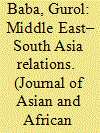

|
|
|
|
|
| Summary/Abstract |
The politico-economically uneven structure, fragile inter-state affairs and weak regionalism of the Middle East make it difficult to explain its interactions with South Asia within a single theoretical pattern. Neither interregionalism nor multilateralism could illuminate these interactions individually. This study merges recently popularized interaction schemes of minilateralism and bilateralism on a transregional basis to provide an eclectic and flexible conceptual framework to explain the patterns of Middle East–South Asia inter-state affairs. It argues that regardless of its weak regionalism and intra-regional power games, the Middle East, with these trendy interaction schemes, could still develop effective inter-state relations with South Asia. The study utilizes the empirical analysis method to interpret various levels and types of interactions between actors of various capabilities. In addition, it also uses case studies to produce a deeper context-dependent knowledge of Middle Eastern – South Asian actors.
|
|
|
|
|
|
|
|
|
|
|
|
|
|
|
|
| 6 |
ID:
190894
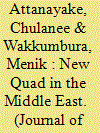

|
|
|
|
|
| Summary/Abstract |
The emerging geopolitical tension and the trade competition in the Indian Ocean urge Sri Lanka to plan its diplomatic ties prudently encouraging Sri Lankan decision-makers to envisage a new strategy for international diplomatic cooperation: minilateralism. This diplomatic engagement mode enables smaller states to cooperate with greater powers in small-scaled/sized cooperation patterns to increase their international opportunities. Since the Indian Ocean has become a hotspot of maritime trade competition and various geostrategic developments, Sri Lanka aspires to new venues for international cooperation. The ‘new Quad’ formed among the United States, India, Israel, and the United Arab Emirates can be a potentially lucrative partnership for a littoral state like Sri Lanka. Amid these developments, this paper seeks to fill a void by delving into the strategic reasons for Sri Lanka’s engagement with the Middle East via minilateralism. This paper investigates the newly strategising affairs of the ‘new Quad’ which two of their member states, Israel and UAE are from the Middle East, and views on how Sri Lanka can benefit in economic ties and crisis management realms to deal with energy and maritime trade issues.
|
|
|
|
|
|
|
|
|
|
|
|
|
|
|
|
| 7 |
ID:
178697
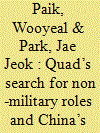

|
|
|
|
|
| Summary/Abstract |
The Quadrilateral Security Dialogue (‘Quad’)—a cooperative consisting of the US, Japan, Australia, and India—has re-emerged since 2017 after a decade of dormancy. After typologizing the minilateral security cooperation’s goals and its expansion, this article explains that the current Quad is an expanded minilateral cooperation of the existing various security bilaterals and trilaterals among its member states. This minilateral has increased its non-military cooperation, focusing on infrastructure-building to counter that of China’s Belt and Road Initiative in the Indo-Pacific region. It also examines how China has been responding to this line of the Quad’s economic responses, while China is cautious about the Quad’s security implications. It concludes with some predictions as to how this set of interactions is likely to influence the regional order.
|
|
|
|
|
|
|
|
|
|
|
|
|
|
|
|
| 8 |
ID:
097126
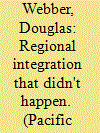

|
|
|
|
|
| Publication |
2010.
|
| Summary/Abstract |
A decade ago, in the aftermath of the Asian financial crisis, numerous observers expected regional integration to take off in East Asia. What, meanwhile, has actually happened? This paper argues that while overall inter-state cooperation has certainly intensified in East Asia during this period, there has been no significant expansion of multilateral, as opposed to bi- or minilateral cooperation and less still any political integration. It explores the reasons for the emergence of this pattern of cooperation in the region, in particular the extent that it has been shaped by ASEAN, which, unwilling and unable as it is to sponsor any far-reaching projects for much closer, region-wide multilateral cooperation, provides no more than a 'soft core' of East Asian regionalism. The failure of political integration to take off is attributed to the antagonistic character of Sino-Japanese relations, the relative weakness of the mobilization of transnational business interests in favour of closer regional cooperation and continuing wide disparities in terms of levels of economic development and political systems. The apparent success that ASEAN has had in maintaining peaceful relations between its members suggests that 'hard' integration is not indispensable for securing regional stability and peace. However, if realist scholars are correct that a changing balance of power is destabilizing the region, the sooner the norms and practices of cooperation that have stood ASEAN in good stead in this regard become entrenched among the region's big powers - whose participation in forums such as the ASEAN Plus Three and East Asian Summit is very recent - the better.
|
|
|
|
|
|
|
|
|
|
|
|
|
|
|
|
| 9 |
ID:
163427


|
|
|
|
|
| Summary/Abstract |
A key feature of Asia’s evolving strategic landscape is U.S. efforts to promote policy coordination and interoperability among its allies and partners, through dialogues, exercises, intelligence-sharing agreements, and other means. Though useful in addressing practical issues and underscoring shared values, a concern is that these ‘minilateral’ activities could exacerbate Chinese fears of ‘encirclement’ and lead to strategic or economic counter-moves. However, this article suggests that a new ‘security dilemma’ in Asia is not likely. Although Chinese officials and analysts are apprehensive about U.S. bilateral alliance developments, they have largely discounted the emergence of an ‘Asian NATO’ under U.S. stewardship. This is due to perceived divergences between U.S. allies, many states’ economic dependence on China, and U.S. self-restraint. This should open possibilities for greater minilateral cooperation under most conditions.
|
|
|
|
|
|
|
|
|
|
|
|
|
|
|
|
| 10 |
ID:
193017
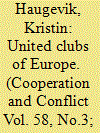

|
|
|
|
|
| Summary/Abstract |
This article makes the case for integrating informal, social and minilateral dynamics in analyses of ‘differentiated integration’ in the European Union (EU) context. In EU studies, differentiated integration has mainly served as an analytical lens for studying variation in states’ degree of formalized commitment to the European integration project or in organizational decision-making procedures across policy areas. While this focus has generated important analytical and empirical insights, three dimensions tend to be lost when limiting the study of differentiated integration to negotiated outcomes manifest in legal documents and decision-making procedures. First, informal processes of integration precede and concur with formal ones. Second, European integration is an inherently social process, and member states integrate with the EU identity-building project in different ways and to different degrees. Third, member states enjoy heterogeneous social ties with one another, routinely forming informal bi- and minilateral coalitions in everyday decision-shaping processes. More knowledge about these informal and social dynamics can give us a better understanding of how differentiated integration manifests itself in practice and where the European integration process is heading. The theoretical argument is buttressed by data from the 2020 European Council of Foreign Relations’ ‘Coalition Explorer’ survey, showing how partner preferences within the EU continue to reflect stable social sub-orders.
|
|
|
|
|
|
|
|
|
|
|
|
|
|
|
|
|
|
|
|
|